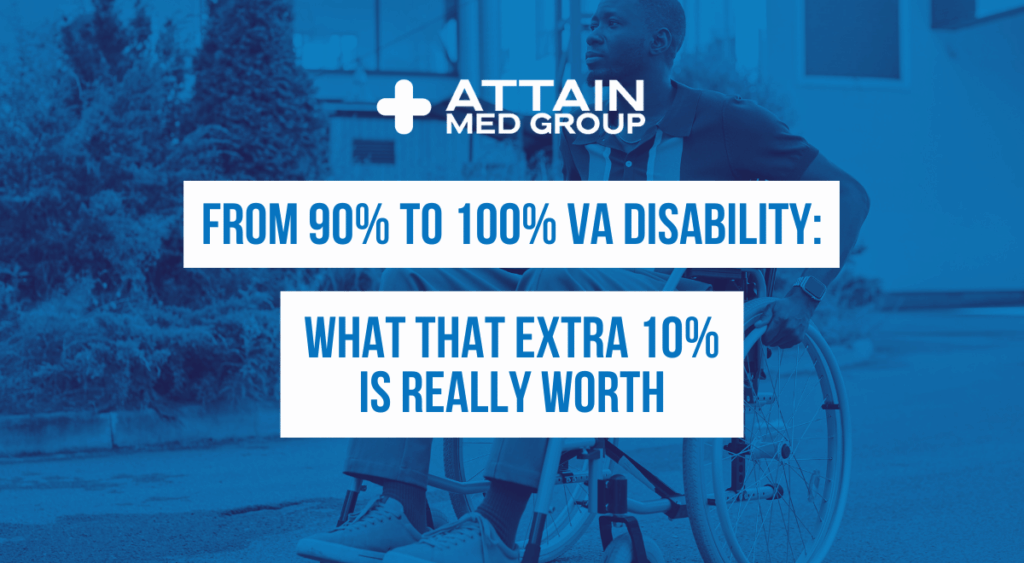That 90% VA disability rating can feel like being stranded just feet from the shore. You can see the safety of 100%, you know what it would mean for your family, but a strange current seems to hold you back. Making the final leap from 90% to 100% VA disability: what to expect, and how strategic medical documentation like Nexus Letters can help veterans make the leap is possible with a clear plan.
You have fought the hard fight to get this far in your VA disability claim, but the journey is not quite over. Many veterans get stuck here, frustrated by the VA’s method of calculating ratings. Understanding the next steps is crucial to securing the disability compensation you’ll need for your future.
This is about more than just numbers; it’s about getting the full disability benefits you earned through your military service. It’s about knowing from 90% to 100% VA disability: what to expect, and how strategic medical documentation like Nexus Letters can help veterans make the leap successfully. Let’s break down how you can approach this final challenge.

The 90% Hurdle: Why It’s So Tough to Cross
You might look at your disability rating and think, “I just need 10% more.” But if you have been in this process for a while, you probably know it is not that simple. This difficulty is because of a system commonly called “VA Math.”
The VA does not just add your disability percentages together. Instead, they use a formula that calculates a combined rating based on the remaining efficiency of the whole person. For example, if you are 100% healthy, a 50% rating for one service-connected condition reduces your efficiency to 50%.
If you then get a 30% rating for another condition, that 30% is applied to the remaining 50% of your efficiency, not the original 100%. This method makes each additional percentage point harder to get as your combined rating gets higher. The gap between a 90% and 100% VA disability rating is huge because you are working with a much smaller remaining percentage, which is why so many veterans feel like they’re hitting a wall.
What a 100% Rating Really Means for You
Reaching a 100% schedular rating or getting Total Disability based on Individual Unemployability (TDIU) opens up a world of benefits. It is life-changing for many veterans and their families. The peace of mind that comes with this level of support cannot be overstated.
Of course, there is a substantial increase in monthly disability pay, which can be the difference between struggling and stability. But the benefits go much further than just disability compensation. You and your dependents could become eligible for healthcare through programs like CHAMPVA, a comprehensive health benefits program.
Other major advantages can include VA dental care, state-level property tax exemptions, and even the potential for student loan forgiveness. These benefits can lift huge financial burdens off your shoulders. For your family, it also means eligibility for Dependents’ Educational Assistance and improved Dependency and Indemnity Compensation (DIC) benefits if you pass away from a service-connected disability.
Strategic Pathways to 100%
So, how do you cross that final barrier to get the rating you deserve? There is not a single path that works for everyone. You have a few options to consider based on your specific situation with your service-connected conditions.
The two most common routes are achieving a 100% schedular rating or being granted total disability based on individual unemployability (TDIU). Both options result in receiving disability pay at the 100% rate. Choosing the right path depends on your medical evidence and your ability to work.
A schedular rating is what most veterans think of when they file a claim. It is when your individual disability ratings combine to 100% using the VA’s formula. Getting there from 90% almost always requires either a rating increase for an existing service-connected condition or adding a new service-connected condition to your file.
TDIU is a bit different, offering an alternative for veterans whose service-connected disabilities prevent them from maintaining a steady job. It pays at the 100% rate even if your schedular rating combined is lower. It is an important option for veterans unable to maintain gainful employment due to their disabilities.

Reaching a 100% Schedular Rating
To reach a 100% schedular rating, you will need more compelling evidence. If one of your existing conditions has gotten worse since your last rating decision, you can file for an increased VA disability rating. This means you will need new medical records showing a worsening of symptoms.
Another strong approach is filing for secondary conditions. These are health problems caused or aggravated by an already service-connected disability. For example, depression that develops because of chronic pain from a service-connected back injury, or sleep apnea secondary to PTSD, could be a secondary service-connected condition.
Proving these connections is everything in the VA claims process. You need to show the VA the link between your military service and the new or worsened condition. This is where your evidence becomes your most powerful tool to get a higher rating.
Understanding TDIU as an Alternative
TDIU might be a better option if your multiple conditions severely impact your ability to earn a living. The VA grants TDIU if you cannot hold down what they call substantial gainful employment due to your service-connected disabilities. It is important to understand this specific definition.
Generally, to be eligible for TDIU, you must meet certain rating thresholds. The VA requires you to have one service-connected condition rated at least 60%, or two or more with a combined rating of 70% or more, with at least one rated at 40% or more. Many veterans meet VA requirements for TDIU without realizing it.
If you meet these thresholds, you can file a claim for TDIU. The VA will then look at all your evidence, including medical records and employment history, to decide if your disabilities truly prevent you from working. Keep in mind that doing odd jobs to make ends meet does not typically count as substantial gainful employment.
The Power of Strategic Documentation
Whether you are seeking a schedular increase or TDIU, your VA claim will rise or fall based on the strength of your evidence. The VA operates on proof. Simply telling them your condition is worse or connected to service is not enough; you must show them with clear, professional documentation to get your claim approved.
This is the part of the process where many veterans get stuck. You know how your disabilities affect you every day, but translating that reality into the language the VA understands is a serious challenge. You need to build a case that is impossible for VA raters to deny.
Strategic medical documentation is how you do that, especially when it is not your initial filing. It is about more than just your regular treatment notes. It involves gathering specific evidence designed to answer the questions a VA rater will have and to establish a clear service connection.
The Power of a Nexus Letter
A Nexus Letter is one of the most powerful pieces of evidence you can submit for your disability claim. It is a medical opinion from a qualified healthcare professional that directly links your condition to your military service. A nexus letter VA can bridge the gap between your medical history and the service connection requirement, making it easier for the VA to grant your claim.
Why is this so effective? A VA rater is not a doctor, so they rely on expert medical opinions to make their decisions. A clear, well-reasoned letter from a doctor explaining the connection gives the rater the justification they need to approve your VA disability claim.
A strong nexus letter contains three key elements. First, the medical provider should state they have reviewed all your relevant medical and service records. Second, they must provide a clear medical opinion on the connection between your condition and your service. And third, they must explain the medical reasoning behind their opinion in detail.
The best nexus letters often use specific phrasing the VA looks for, stating that your condition is “at least as likely as not” related to your military service. This language directly addresses the VA’s standard of proof. A va nexus letter with this kind of clear statement from an expert medical professional is incredibly persuasive and can be the deciding factor.

Beyond the Nexus Letter: Other Key Documents
While nexus letters are a game-changer, they are not the only piece of important evidence. You should build a comprehensive file that tells your whole story. Buddy Letters, also known as lay statements, can be very helpful in supporting your VA claims.
These are statements from friends, family, or fellow service members who have witnessed how your disabilities affect you. They can describe the changes they have seen in you since you were leaving service. This personal testimony adds a human element to your file that medical records alone cannot convey.
You should also write a personal statement. This is your chance to tell the VA, in your own words, how your conditions limit your daily life and ability to work. Be honest, be detailed, and focus on the functional impact of your symptoms; do not just list diagnoses.
Finally, make sure you have complete and current medical records. Showing that you are actively seeking treatment for your conditions demonstrates that they are ongoing problems. Continuous medical evidence reinforces the severity and chronicity of your disabilities and is a crucial part of any rating condition increase.
Preparing for the Final Push
Once you have decided on a strategy and started to include evidence, it is time to get organized. Create a checklist of every document you have and every document you still need. A well-organized file makes it easier for the VA rater to see the strength of your case and is less likely to be denied simply due to a lack of organization.
You should also prepare for a Compensation and Pension (C&P) exam, as the VA will likely request one. The VA will schedule an exam with a contracted doctor to evaluate your condition. This exam is extremely important, and your conduct during it can have a big impact on the outcome.
Before your exam, review your records so your own history is fresh in your mind. During the appointment, be completely honest about your symptoms and how they impact you on your worst days. Do not exaggerate, but also do not downplay the severity of your conditions.
After you have filed your claim and completed your exam, the waiting period begins. This can be the hardest part of the claims process. You can check the status of your claim online, but try not to become obsessed with it. You have done the hard work of building a strong case; now the system needs time to work.
If your claim is not progressing or you feel overwhelmed, consider consulting a VA disability attorney. This type of legal professional requires expertise in VA law and can help you organize your claim, review your evidence, and file appeals if necessary. Their help can be invaluable in these final stages.

Conclusion
That last 10% on the journey to a 100% va rating is undoubtedly the toughest part. The system can feel confusing and unfair, but it is not impossible to navigate successfully. By understanding VA Math, choosing the right strategy, and building a powerful case with solid evidence, you can take control of the process.
Focusing on getting from 90% to 100% VA disability: what to expect, and how strategic medical documentation like Nexus Letters can help veterans make the leap is your most effective plan for success. A strong nexus can be the missing link for many veterans to develop additional conditions after service. With persistence and the right documentation, you can secure the benefits you rightfully earned.

